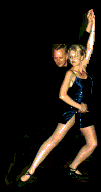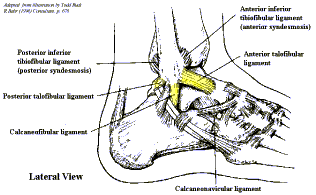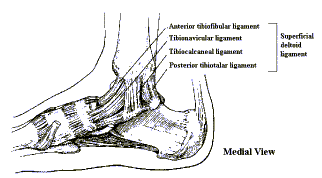StreetDance Australia's
Free Online Books

|
Welcome to StreetDance Australia's Free Online Books |
 |
|
|
Knowing your Body...
Preventing Dance Injuries - Anatomy of the Foot and Ankle By Paul F. Clifford The foot consists of twenty-six bones, twenty-nine joints, thirty-one muscles, and many ligaments, tendons, nerves, arteries and veins. The bones of the foot are divided into three groups; seven tarsal bones, five metatarsal bones and fourteen phalange bones. The two largest and most important of the tarsal bones are the Talus and the Calcaneum, (otherwise known as the heel bone). The lower end of the Achilles tendon is attached to the calcaneum and the talus sits on top of the calcaneum, the joint between them is known as the Subtalar joint. The upper part of the talus forms part of the ankle joint. The metatarsal bones extend out in front of the ankle to the base of the toes. The phalanges are the bones of the toes themselves, and each toe has three except for the big toe, which has only two. You can experience a stress (hairline) fracture to the metatarsal bone if you continually dance on hard surfaces. The fracture is the consequence of accumulated impact and shock. Symptoms may be swelling and redness. These subside with rest but may resume with activity.  A form of arthritis called Hallux Rigidus can affect the joint between the foot and the big toe. Continued irritation to the big toe causes joint enlargement and inflammation. Pain and restriction of movement at this joint is a severe disability which can limit your dancing. Complete rest and treatment by a trained physiotherapist is advised. There is a great deal of movement in the toes and in the ankle region but some of the other bones have very little movement between them. Another important joint for dancers is the Ankle joint, located between the talus and the inferior ends of the tibia and fibula bones. Both these bones have a downward projection, which enclose the talus and stabilise the ankle joint. The knob on the outside of the ankle (the projection of the fibula), is called the Lateral Malleolus, while the bony projection (part of the tibia), on the inside is known as the Medial Malleolus. The ankle joint is held together by ligaments. The most important of these are the Medial and Lateral ligaments which join the talus to the tibia and fibula. The lateral ligament is the one that you damage when you sprain your ankle and if it becomes completely torn, the ankle becomes very unstable.  The only movement that can occur in the ankle joint is pointing and flexing of the foot. The medical terms for these actions are Plantar-flexion for pointing of the foot, controlled by the Soleus muscle and Dorsi-flexion for the flexion of the foot controlled by the Tibialis anterior. Its counterpart is known as the Tibialis Posterior. Their tendons pass around the inner ankle and under the foot. An accessory muscle to the Soleus is the Digitorum longas. The Subtalar joint provides the other movement of the ankle. The movement occurring in this joint is a side to side rolling movement, which allows you to adapt to a sloping or uneven ground. Plantar Fascial Strain, can occur from jarring stresses to the foot. Plantar fascia is asheet of fibrous tissue that extends from the heel to the bases of the toes, enfolding and supporting the muscle and other structures under the foot and maintaining the arch. Damage to this tough membrane causes pain and irritation of movement, and is considered by many physicians to be one of the most common serious injuries for dancers. The muscles of the foot can be divided into two main groups; Intrinsic and Extrinsic. The intrinsic muscles are short and relatively weak and are contained only in the foot. The extrinsic muscles are powerful, and are found in the lower leg with their tendons passing through the ankle region exert their effect within the foot. The most powerful of the extrinsic muscles is the Gastrocnemius which acts through the Achilles tendon on the calcaneum and when it contracts it helps to raise the heel off the ground. There is a group of tendons that run behind the inside ankle joint, and whose main effect is to point the toes as well as a group that run down the anterior side to flex the foot, as well as moving other parts of the foot. The tendons behind the outside ankle bone go to the structures on the outer side of the foot. Dancers who continually dance on a hard floor will sometimes develop pain above the calcaneus in the area of the Achilles tendon; this condition, commonly referred to a dancerís heel, is caused by inflammation secondary to trauma in the joint between the calcaneus and the talus. Pointing the foot brings about the pain. Since standard physical therapy techniques sometimes have little effect, the most appropriate treatment is rest. Practically speaking, that means dancing and walking flat-footed. There are numerous injuries you can encounter in the foot and ankle. Most are treatable, some present long term annoyance. My best advice is to avoid them all. However, sometimes things can be completely out of your control. Some time ago, I was trod on by a female dancer, her high heels slammed into the top of my foot, just below the ankle. The immediate pain was bad, but it subsided into a periodic ache. The next day I forgot about it, but from then, every time I danced I got aches and pains in my knee and ankle. I had a weakened foot and my body was trying to compensate. Over a lengthy period of time this minor injury compounded into something worse, resulting in strained ligaments, muscle tear, burstitus and finally a clot in the leg. I haven't been able to dance for some period of time now. Don't let this happen to you! If you have any injury, no matter how seemingly minor, see your doctor, it might save you from a long term injury which prevents you from dancing. Press one of the following to continue Part 1 - Preventing Dance injuries Part 2 - Avoiding injury to the Knee Part 3 - Avoiding injury to the Foot and Ankle Part 4 - Anatomy of the Foot and Ankle References:
|
|
Press Ctrl-D to Bookmark this page!
Something new will appear at StreetDance most months. Stay up-to-date! Sign up for our free newsletter! Email us! If you enjoyed StreetDance's articles. Tell your friends about this site! Email them! If you found something lacking, tell us and it will be fixed! Tell us what you would like to read about! So talk to us! Feedback. StreetDance@mail.com |
Got a question? Click here! Want to know something more about Latin StreetDance click on one of the followng Dance History Mambo, Cha Cha & Salsa | Merengue | Samba Latin Dance Technique Feeling | Technique | Tricks & Tips | The Yambus | The Clave Basic Timing and Steps Mambo | Cha Cha | Salsa | Merengue | Samba Basic Choreography Mambo, Cha Cha & Salsa | Merengue | Samba Other Stuff Articles | Gig Guides | Dance Videos | Classifieds | Links | Home |